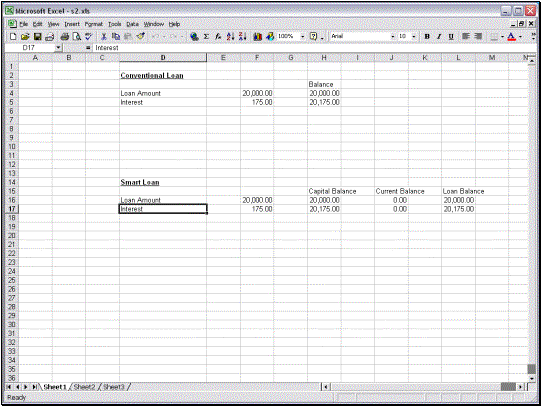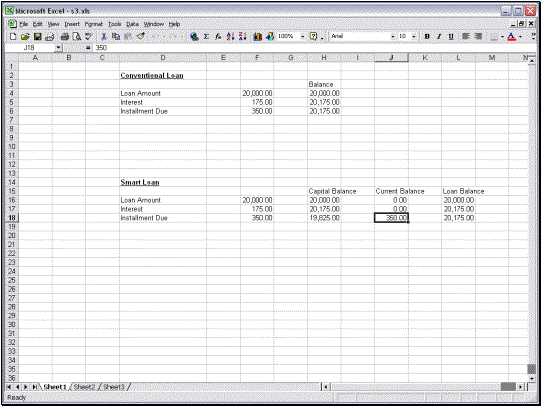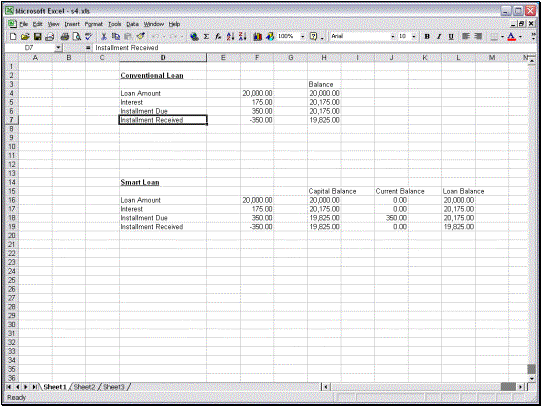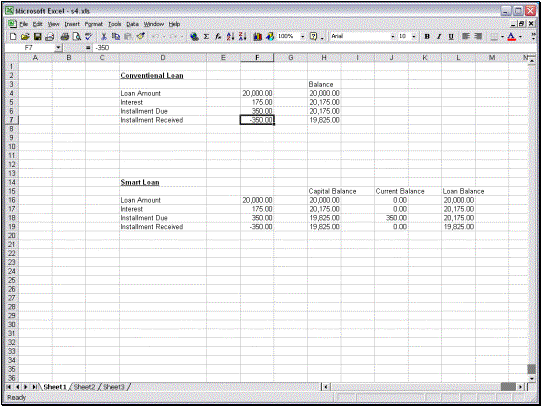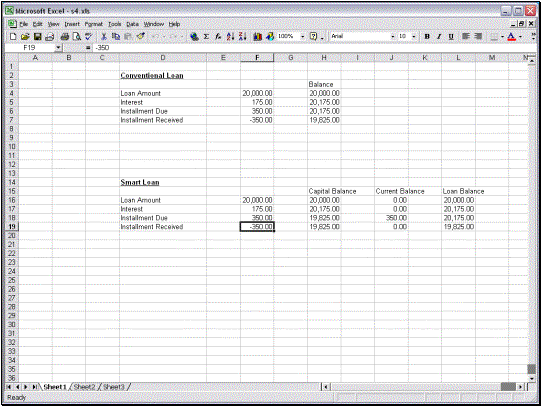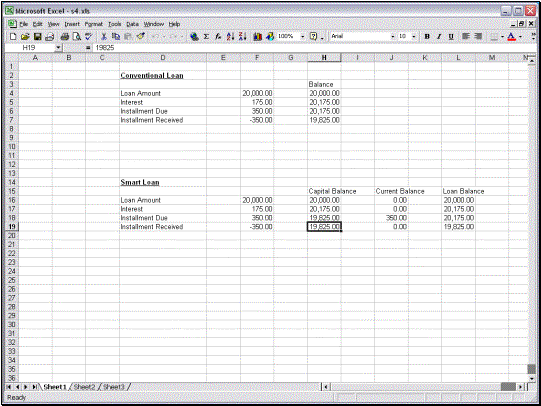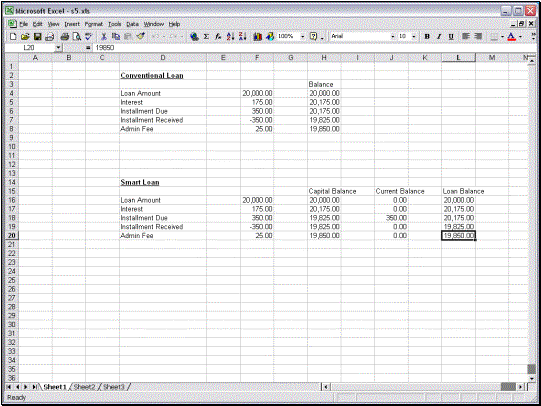The Consumer Loans
include Loans like Mortgage, Seasonal, Revolving, Hire Purchase and Long
Term. The important difference
between all of these Loans and Conventional Loans are that all of these Loans
are Smart Loans. Our purpose in this
tutorial is to create an understanding of how the functions of a Smart Loan
extend those of a Conventional Loan. |
So here we are looking
at an example of a Loan Calculation. So we have a Principal
amount here of 189,100 and we have an Installment of 2,500 and this Loan runs
over a Period of 10 Years What we want to note
here is that with each Payment we can see the portion of the Payment that
represents Interest and we can see the portion that represents
Principal. Then we can see what the
remaining Balance will be in each case. As the Loan progresses
over the payment period, we can see that with each installment the Interest
Portion is reducing and the Principal Portion is increasing. So eventually we get to
a stage where the Loan is fully paid off.
|
|
|
|
|
Now
we are going to use a Spread Sheet to show how we can represent the different
Transactions that take place during the lifetime of a Loan and comparing
between the Conventional Loan and the Smart Loan. |
In a Conventional Loan,
once we have granted the loan amount and it has been drawn down, then the
Balance for the Loan will be 20,000, in this particular example. When we look at the
Smart Loan, we see the same. 20,000 being drawn down. But now we show a
Capital Balance of 20,000. A Current Balance of Zero and a Loan Balance of
20,000. |
So in the case of a
Smart Loan we have 3 columns. The last column, which is the Loan Balance, is
the same as that of a Conventional Loan. But in addition we always have a
View of the Capital Balance part of the Loan Account. We also have the Current Balance part of
the Loan Account. |
|
|
|
|
|
Next we show the first Interest Transaction where Interest is being
charged against the Loan and as we look at the Conventional Loan, there is
Interest of 175.00 being charged. This then results
in a Loan Balance now of 20,175. |
|
|
|
Now the Smart Loan is
exactly the same except that the Interest goes directly to Capital. So the Capital increases
to 20,175. But the current Account,
the Current Balance, remains at Zero. The Loan Balance, which we compare with
the Conventional Loan, of course is also 20,175. |
|
|
|
|
The next transaction we
look at is an Installment that is due.
In a Conventional Loan, this is not a transaction that is shown at
all, as we can see. Although an Installment
is due per the Loan Agreement, the balance remains the same, $20,175. In fact
there is no transaction on this Loan. When we look at the
Smart Loan, we see something different. |
|
|
|
In the case of a Smart
Loan the Installment of 350 that is due, is taken out of Capital and
transferred to Current Balance because this is actually like a Current
Balance that is due and should be paid. So the Capital is
credited with the Installment and the Current/Arrears Portion of the Loan is
charged or debited with this Installment. The Net effect on the
overall Loan Balance is of course exactly the same as with the Conventional
Loan. |
|
|
|
So when the Loanee
actually pays the Installment on the conventional loan, we can see a Credit
amount of 350.00 and this reduces the overall Loan Balance in this case to
19,825.00. Now let us take a look
at what happens on the Smart Loan. |
|
|
|
On the Smart Loan the
Capital remains unaffected because the Capital has already previously been
reduced by this Installment. But the
Installment received is actually Credited to the Current portion of the Loan. In other words, if the
Installment is not received, then we can clearly see an overdue Balance of
350.00. When it is paid, then of
course the current Balance in this case now is zero. Then the total Loan
Balance of 19,825.00 is exactly the same as in the Conventional Loan. So we are beginning to
see here that we just have better management and better information, but the
Net effect on the total Loan Balance is still the same. |
|
|
|
|
The
next transaction example that we are looking at here, is an Admin Fee, which
on the Conventional Loan is being charged as 25.00 and of course the Loan
Balance is affected by this and the amount owing is now 19,850.00. |
|
|
|
When we look at the
Smart Loan, we will see that the norm is usually for other charges, other
than Installments, to be charged automatically to the Capital Balance. So the Capital Balance
in this case increases to 19,850.00, which is also the overall Loan Balance,
whereas the current Account is unaffected by this. It is so that when we
perform Transactions, both Receipts and Charges, we can designate a specific
portion of the Loan to be affected by this, but usually the Charges will be
going to Capital. The Installment will go to the Current / Arrears and of
course both portions of the Loan can attract interest. |
|
So we can say that the
understanding that we wish to create here is that the Smart Loan does
everything that the Conventional Loan does. In addition it also has
more views, i.e. a split view of that overall Loan, into the Capital portion
and also the Current/Arrears portion.
In each of these two portions of the Loan, we have the possibility of
Debit balances and also the possibility of Credit balances i.e. advanced
Payments and therefore on the Smart Loan, we have four Interest Indicators
rather than one, as in the case of the Conventional loan. In the case of the Smart
Loan, we can choose to charge different Interest Rates on the Capital and on
the Arrears, the Current part of the Loan and also we can give Credit
Interest for Advance Payments on the Capital Portion and also on the
Current/Arrears portion of the Loan if we want to. |
|
|


















